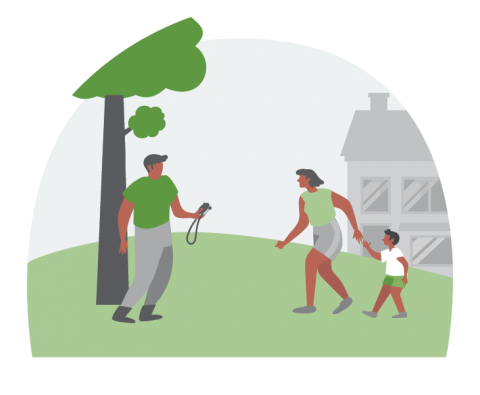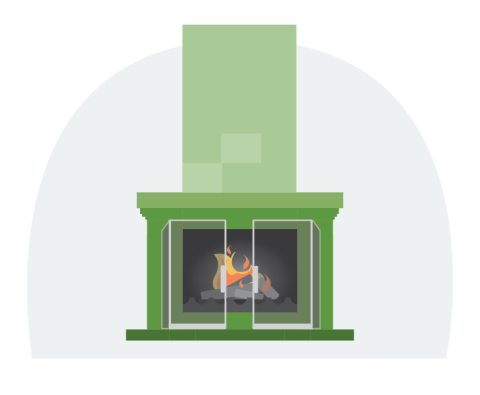Learn About Fires
Before a Fire
During a Fire
After a Fire
Prevent Home Fires
Escape Plan
Associated Content
A fire can become life-threatening in just two minutes. A residence can be engulfed in flames in five minutes.
Learn About Fires
- Fire is FAST! In less than 30 seconds a small flame can turn into a major fire. It only takes minutes for thick black smoke to fill a house or for it to be engulfed in flames.
- Fire is HOT! Heat is more threatening than flames. Room temperatures in a fire can be 100 degrees at floor level and rise to 600 degrees at eye level. Inhaling this super-hot air will scorch your lungs and melt clothes to your skin.
- Fire is DARK! Fire starts bright, but quickly produces black smoke and complete darkness.
- Fire is DEADLY! Smoke and toxic gases kill more people than flames do. Fire produces poisonous gases that make you disoriented and drowsy.
Smoke Alarms
A working smoke alarm significantly increases your chances of surviving a deadly home fire.
- Replace batteries twice a year, unless you are using 10-year lithium batteries.
- Install smoke alarms on every level of your home, including the basement.
- Replace the entire smoke alarm unit every 10 years or according to manufacturer’s instructions.
- Never disable a smoke alarm while cooking – it can be a deadly mistake.
- Audible alarms are available for visually impaired people and smoke alarms with a vibrating pad or flashing light are available for the hearing impaired.
Before a Fire
Make digital copies of valuable documents and records like birth certificates. If you are insured, contact your insurance company for detailed instructions on protecting your property, conducting inventory and contacting fire damage restoration companies.
Create and Practice a Fire Escape Plan

Remember that every second counts in the event of a fire. Escape plans help you get out of your home quickly. Practice your home fire escape plan twice each year. Some tips to consider when preparing this plan include:
- Find two ways to get out of each room in the event the primary way is blocked by fire or smoke.
- Make sure that windows are not stuck, screens can be taken out quickly and that security bars can be properly opened.
- Practice feeling your way out of the house in the dark or with your eyes closed.
- Teach children not to hide from firefighters.
- If you use a walker or wheelchair, check all exits to be sure you can get through the doorways.
Fire Safety Tips
- Sleep with your bedroom door closed.
- Keep a fire extinguisher in your kitchen. Contact your local fire department for assistance on proper use and maintenance.
- Consider installing an automatic fire sprinkler system in your residence.
During a Fire

- Drop down to the floor and crawl low, under any smoke to your exit. Heavy smoke and poisonous gases collect first along the ceiling.
- Before opening a door, feel the doorknob and door. If either is hot, or if there is smoke coming around the door, leave the door closed and use your second way out.
- If you open a door, open it slowly. Be ready to shut it quickly if heavy smoke or fire is present.
- If you can’t get to someone needing assistance, leave the home and call 9-1-1 or the fire department. Tell the emergency operator where the person is located.
- If pets are trapped inside your home, tell firefighters right away.
- If you can’t get out, close the door and cover vents and cracks around doors with cloth or tape to keep smoke out. Call 9-1-1 or your fire department. Say where you are and signal for help at the window with a light-colored cloth or a flashlight.
- If your clothes catch fire, stop, drop and roll – stop immediately, drop to the ground and cover your face with your hands. Roll over and over or back and forth until the fire is out. If you or someone else cannot stop, drop and roll, smother the flames with a blanket or towel. Use cool water to treat the burn immediately for three to five minutes. Cover with a clean, dry cloth. Get medical help right away by calling 9-1-1 or the fire department.
After a Fire
- Contact your local disaster relief service, such as The Red Cross, if you need temporary housing, food and medicines.
- Check with the fire department to make sure your residence is safe to enter.
- DO NOT attempt to reconnect utilities yourself. The fire department should make sure that utilities are either safe to use or are disconnected before they leave the site.
- Conduct an inventory of damaged property and items. Do not throw away any damaged goods until after you make the inventory of your items.
- Begin saving receipts for any money you spend related to fire loss. The receipts may be needed later by the insurance company and for verifying losses claimed on your income tax.
- Notify your mortgage company of the fire.
Prevent Home Fires
Home fires can be preventable. The following are simple steps that each of us can take to prevent a tragedy.

Cooking
- Stay in the kitchen when you are frying, grilling or broiling food. Turn off the stove if you leave the kitchen for even a short period of time.
- Wear short, close-fitting or tightly rolled sleeves when cooking.
- Position barbecue grills at least 10 feet away from siding and deck railings, and out from under eaves and overhanging branches.
- Keep a fire extinguisher available.
Electrical and Appliance Safety
- Frayed wires can cause fires. Replace all worn, old or damaged appliance cords immediately and do not run cords under rugs or furniture.
- If an appliance has a three-prong plug, use it only in a three-slot outlet. Never force it to fit into a two-slot outlet or extension cord.
- Immediately shut off, then professionally replace, light switches that are hot to the touch and lights that flicker.
Holiday Safety
- Turn off holiday lights at night or when you leave the house.
- Replace any string of lights with worn or broken cords or loose bulb connections.
- Keep candles at least 12 inches away from flammable materials or consider using flameless candles.
- Water your Christmas tree daily and don’t let it dry out. A dry tree is more flammable.
- Make sure your tree is at least three feet away from any heat source, like fireplaces, radiators, candles, heat vents or lights, and not blocking an exit.
- Don’t overload extension cords and outlets.
Fireplaces and Woodstoves
- Inspect and clean woodstove pipes and chimneys annually and check monthly for damage or obstructions.
- Use a fireplace screen heavy enough to stop rolling logs and big enough to cover the entire opening of the fireplace to catch flying sparks.
- Make sure the fire is completely out before leaving the house or going to bed.
Portable Space Heaters
- Keep combustible objects at least three feet away from portable heating devices.
- Only buy heaters evaluated by a nationally recognized laboratory, such as Underwriters Laboratories (UL).
- Check to make sure the portable heater has a thermostat control mechanism and will switch off automatically if the heater falls over.
- Only use crystal clear K-1 kerosene in kerosene heaters. Never overfill it. Use the heater in a well-ventilated room away from curtains and other flammable items.
Keeping Children Safe
- Take the mystery out of fire play by teaching children that fire is a tool, not a toy.
- Store matches and lighters out of children's reach and sight, preferably in a locked cabinet.
- Never leave children unattended near operating stoves or burning candles, even for a short time.
More Fire Prevention Tips
- Never use a stove range or oven to heat your home. It can increase the risk of fires, burns and could damage the appliance. Gas stoves are especially dangerous to use as heat sources because dangerous levels of carbon monoxide could build up, putting you and your family at risk for carbon monoxide poisoning.
- Keep combustible and flammable liquids away from heat sources.
- Portable generators should NEVER be used indoors and should only be refueled outdoors and in well-ventilated areas.


